1st Grade Lesson Activities and Rationale - Elementary Education
VerifiedAdded on 2022/08/22
|11
|2238
|21
Homework Assignment
AI Summary
This assignment outlines various lesson activities designed for 1st-grade students, focusing on listening, speaking, and writing skills. It provides detailed examples of activities, such as a "secret message" game for listening, a "telling the truth" exercise for speaking, and a "recalling winter" writing task. Each activity is aligned with Common Core State Standards and includes specific learning objectives, differentiation strategies, and assessment criteria. The rationale section explains the pedagogical choices behind each activity, emphasizing their suitability for the students' diverse backgrounds and developmental stages. The assignment highlights the importance of effective communication, incorporating verbal and non-verbal elements to enhance student engagement and learning outcomes. References to relevant educational research support the selected teaching methods, making this a comprehensive resource for elementary education teachers. You can find more solved assignments on Desklib.
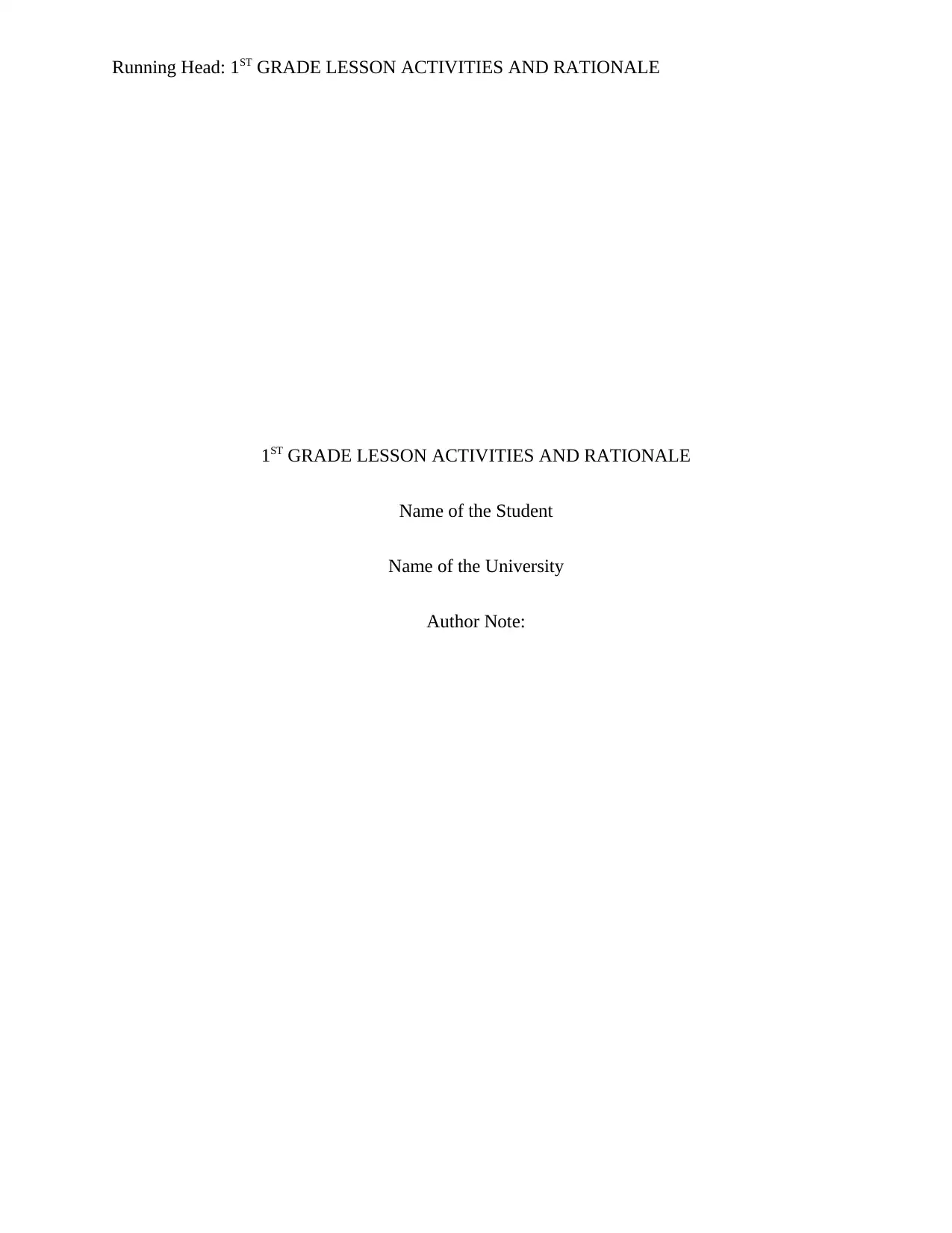
Running Head: 1ST GRADE LESSON ACTIVITIES AND RATIONALE
1ST GRADE LESSON ACTIVITIES AND RATIONALE
Name of the Student
Name of the University
Author Note:
1ST GRADE LESSON ACTIVITIES AND RATIONALE
Name of the Student
Name of the University
Author Note:
Paraphrase This Document
Need a fresh take? Get an instant paraphrase of this document with our AI Paraphraser
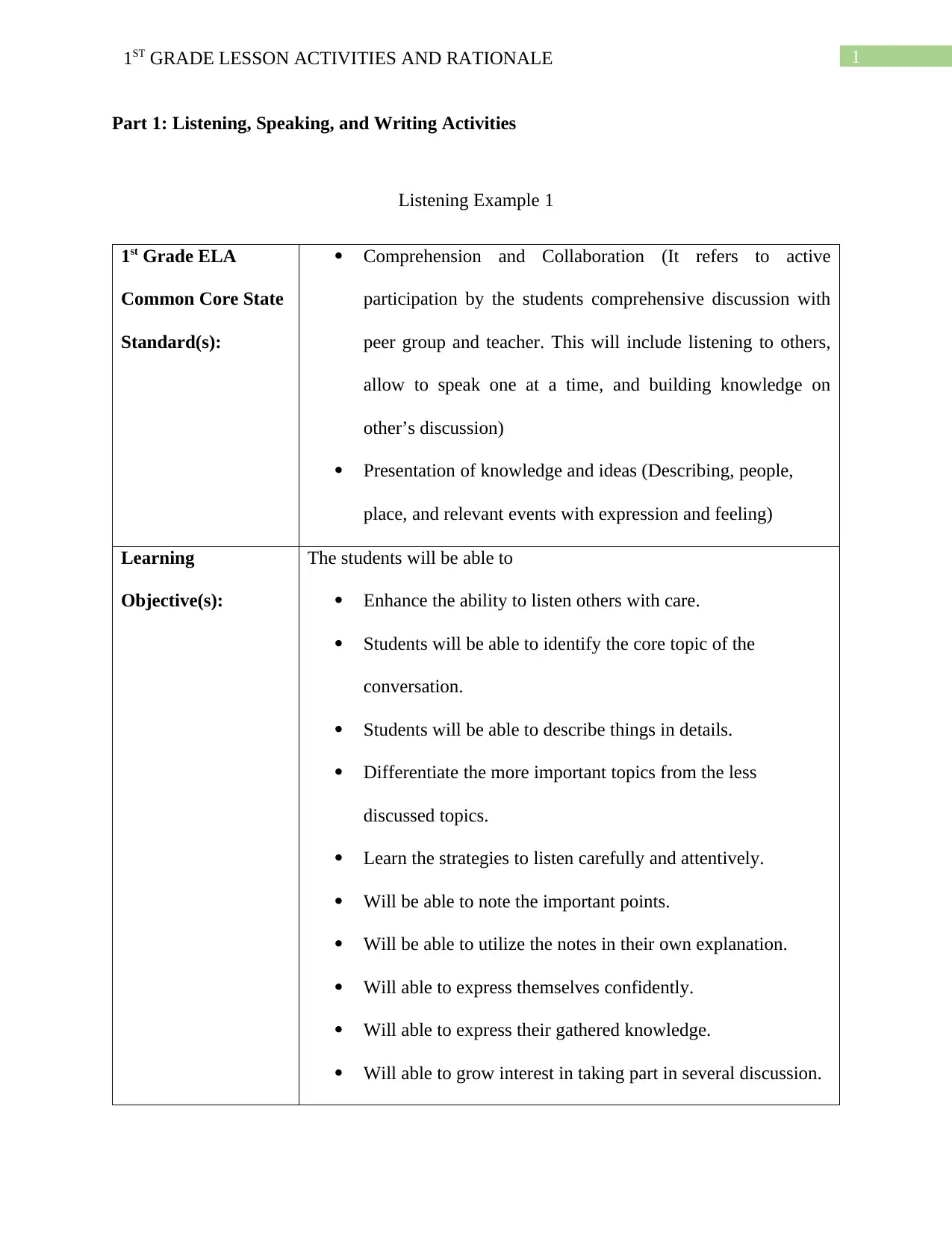
11ST GRADE LESSON ACTIVITIES AND RATIONALE
Part 1: Listening, Speaking, and Writing Activities
Listening Example 1
1st Grade ELA
Common Core State
Standard(s):
Comprehension and Collaboration (It refers to active
participation by the students comprehensive discussion with
peer group and teacher. This will include listening to others,
allow to speak one at a time, and building knowledge on
other’s discussion)
Presentation of knowledge and ideas (Describing, people,
place, and relevant events with expression and feeling)
Learning
Objective(s):
The students will be able to
Enhance the ability to listen others with care.
Students will be able to identify the core topic of the
conversation.
Students will be able to describe things in details.
Differentiate the more important topics from the less
discussed topics.
Learn the strategies to listen carefully and attentively.
Will be able to note the important points.
Will be able to utilize the notes in their own explanation.
Will able to express themselves confidently.
Will able to express their gathered knowledge.
Will able to grow interest in taking part in several discussion.
Part 1: Listening, Speaking, and Writing Activities
Listening Example 1
1st Grade ELA
Common Core State
Standard(s):
Comprehension and Collaboration (It refers to active
participation by the students comprehensive discussion with
peer group and teacher. This will include listening to others,
allow to speak one at a time, and building knowledge on
other’s discussion)
Presentation of knowledge and ideas (Describing, people,
place, and relevant events with expression and feeling)
Learning
Objective(s):
The students will be able to
Enhance the ability to listen others with care.
Students will be able to identify the core topic of the
conversation.
Students will be able to describe things in details.
Differentiate the more important topics from the less
discussed topics.
Learn the strategies to listen carefully and attentively.
Will be able to note the important points.
Will be able to utilize the notes in their own explanation.
Will able to express themselves confidently.
Will able to express their gathered knowledge.
Will able to grow interest in taking part in several discussion.
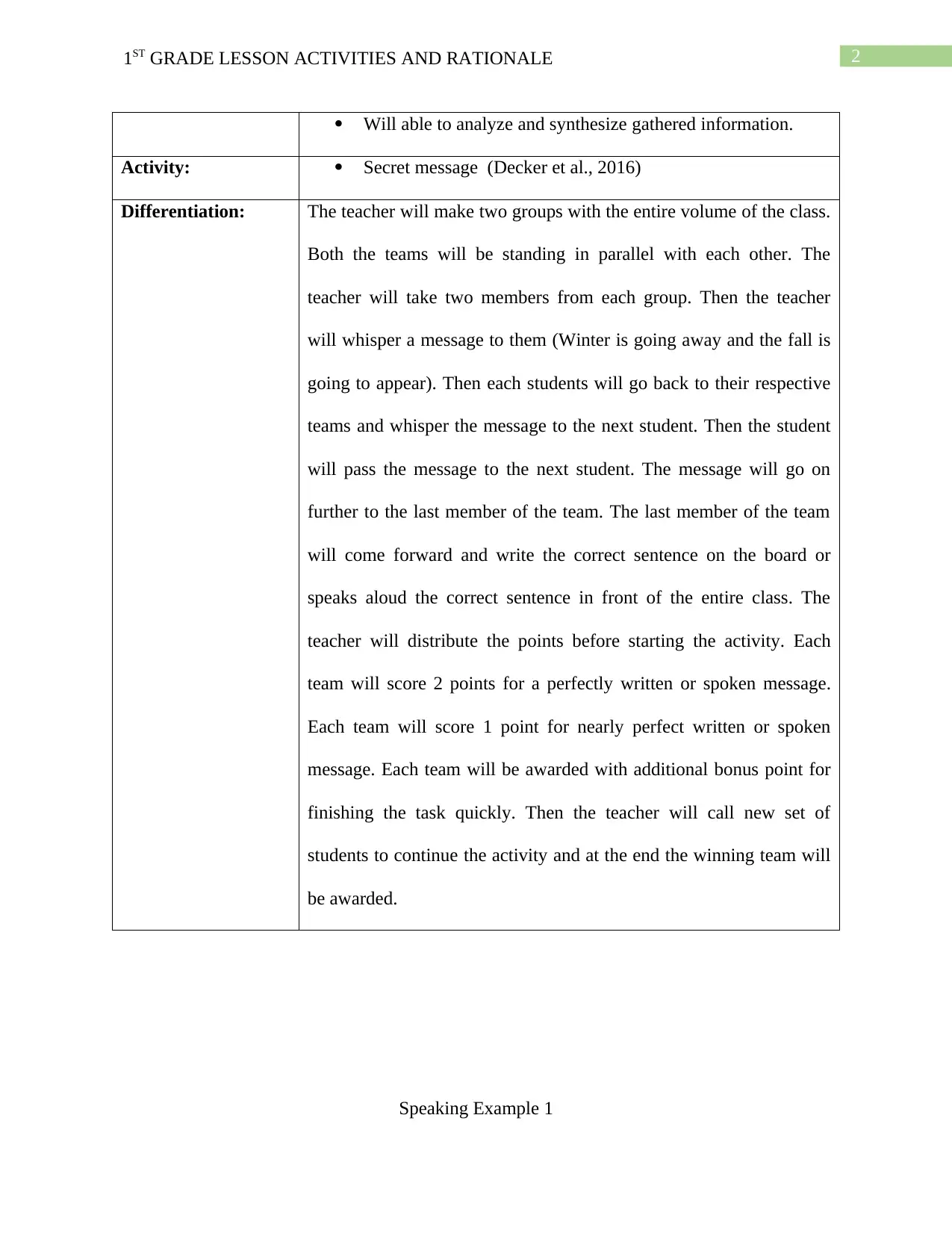
21ST GRADE LESSON ACTIVITIES AND RATIONALE
Will able to analyze and synthesize gathered information.
Activity: Secret message (Decker et al., 2016)
Differentiation: The teacher will make two groups with the entire volume of the class.
Both the teams will be standing in parallel with each other. The
teacher will take two members from each group. Then the teacher
will whisper a message to them (Winter is going away and the fall is
going to appear). Then each students will go back to their respective
teams and whisper the message to the next student. Then the student
will pass the message to the next student. The message will go on
further to the last member of the team. The last member of the team
will come forward and write the correct sentence on the board or
speaks aloud the correct sentence in front of the entire class. The
teacher will distribute the points before starting the activity. Each
team will score 2 points for a perfectly written or spoken message.
Each team will score 1 point for nearly perfect written or spoken
message. Each team will be awarded with additional bonus point for
finishing the task quickly. Then the teacher will call new set of
students to continue the activity and at the end the winning team will
be awarded.
Speaking Example 1
Will able to analyze and synthesize gathered information.
Activity: Secret message (Decker et al., 2016)
Differentiation: The teacher will make two groups with the entire volume of the class.
Both the teams will be standing in parallel with each other. The
teacher will take two members from each group. Then the teacher
will whisper a message to them (Winter is going away and the fall is
going to appear). Then each students will go back to their respective
teams and whisper the message to the next student. Then the student
will pass the message to the next student. The message will go on
further to the last member of the team. The last member of the team
will come forward and write the correct sentence on the board or
speaks aloud the correct sentence in front of the entire class. The
teacher will distribute the points before starting the activity. Each
team will score 2 points for a perfectly written or spoken message.
Each team will score 1 point for nearly perfect written or spoken
message. Each team will be awarded with additional bonus point for
finishing the task quickly. Then the teacher will call new set of
students to continue the activity and at the end the winning team will
be awarded.
Speaking Example 1
⊘ This is a preview!⊘
Do you want full access?
Subscribe today to unlock all pages.

Trusted by 1+ million students worldwide
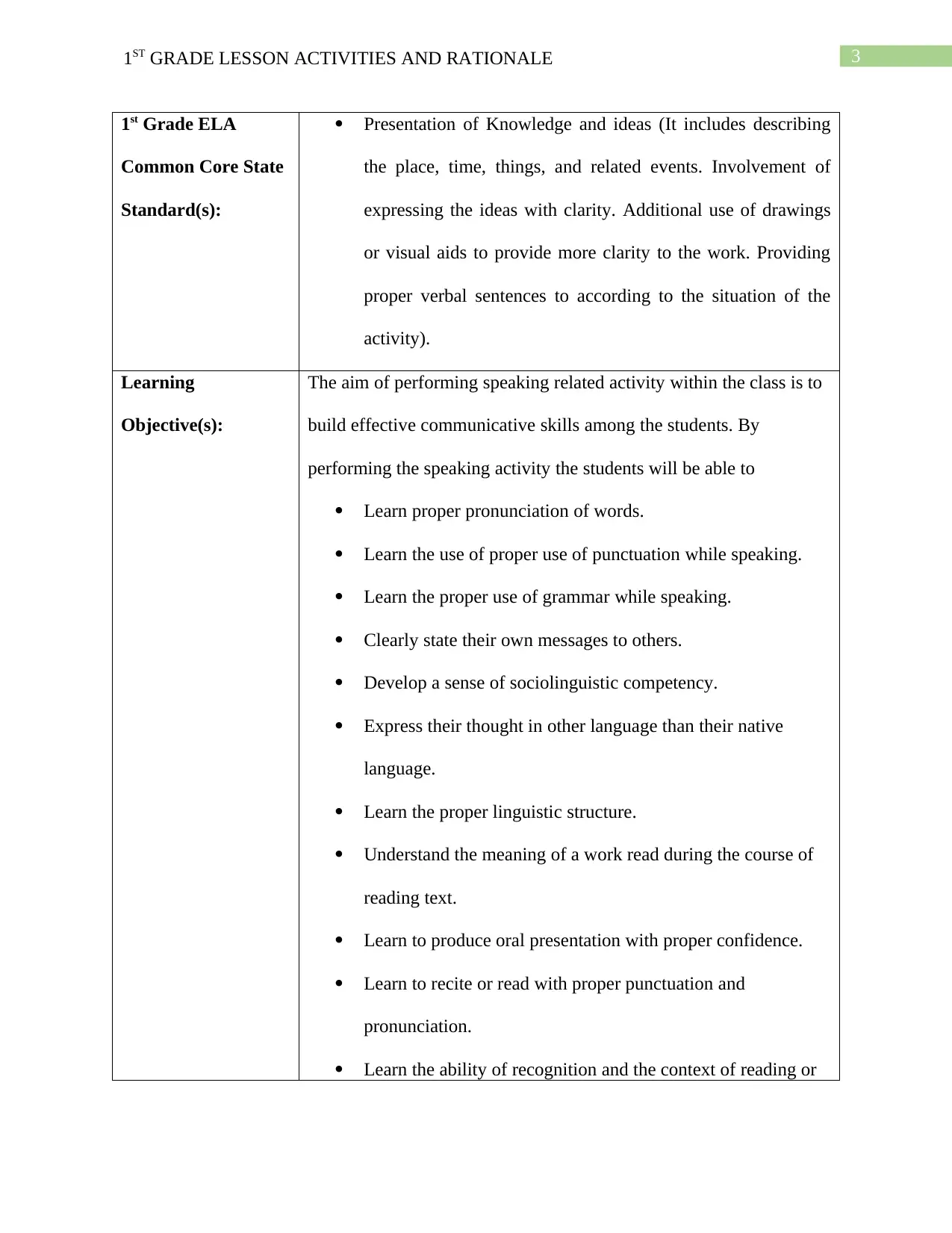
31ST GRADE LESSON ACTIVITIES AND RATIONALE
1st Grade ELA
Common Core State
Standard(s):
Presentation of Knowledge and ideas (It includes describing
the place, time, things, and related events. Involvement of
expressing the ideas with clarity. Additional use of drawings
or visual aids to provide more clarity to the work. Providing
proper verbal sentences to according to the situation of the
activity).
Learning
Objective(s):
The aim of performing speaking related activity within the class is to
build effective communicative skills among the students. By
performing the speaking activity the students will be able to
Learn proper pronunciation of words.
Learn the use of proper use of punctuation while speaking.
Learn the proper use of grammar while speaking.
Clearly state their own messages to others.
Develop a sense of sociolinguistic competency.
Express their thought in other language than their native
language.
Learn the proper linguistic structure.
Understand the meaning of a work read during the course of
reading text.
Learn to produce oral presentation with proper confidence.
Learn to recite or read with proper punctuation and
pronunciation.
Learn the ability of recognition and the context of reading or
1st Grade ELA
Common Core State
Standard(s):
Presentation of Knowledge and ideas (It includes describing
the place, time, things, and related events. Involvement of
expressing the ideas with clarity. Additional use of drawings
or visual aids to provide more clarity to the work. Providing
proper verbal sentences to according to the situation of the
activity).
Learning
Objective(s):
The aim of performing speaking related activity within the class is to
build effective communicative skills among the students. By
performing the speaking activity the students will be able to
Learn proper pronunciation of words.
Learn the use of proper use of punctuation while speaking.
Learn the proper use of grammar while speaking.
Clearly state their own messages to others.
Develop a sense of sociolinguistic competency.
Express their thought in other language than their native
language.
Learn the proper linguistic structure.
Understand the meaning of a work read during the course of
reading text.
Learn to produce oral presentation with proper confidence.
Learn to recite or read with proper punctuation and
pronunciation.
Learn the ability of recognition and the context of reading or
Paraphrase This Document
Need a fresh take? Get an instant paraphrase of this document with our AI Paraphraser
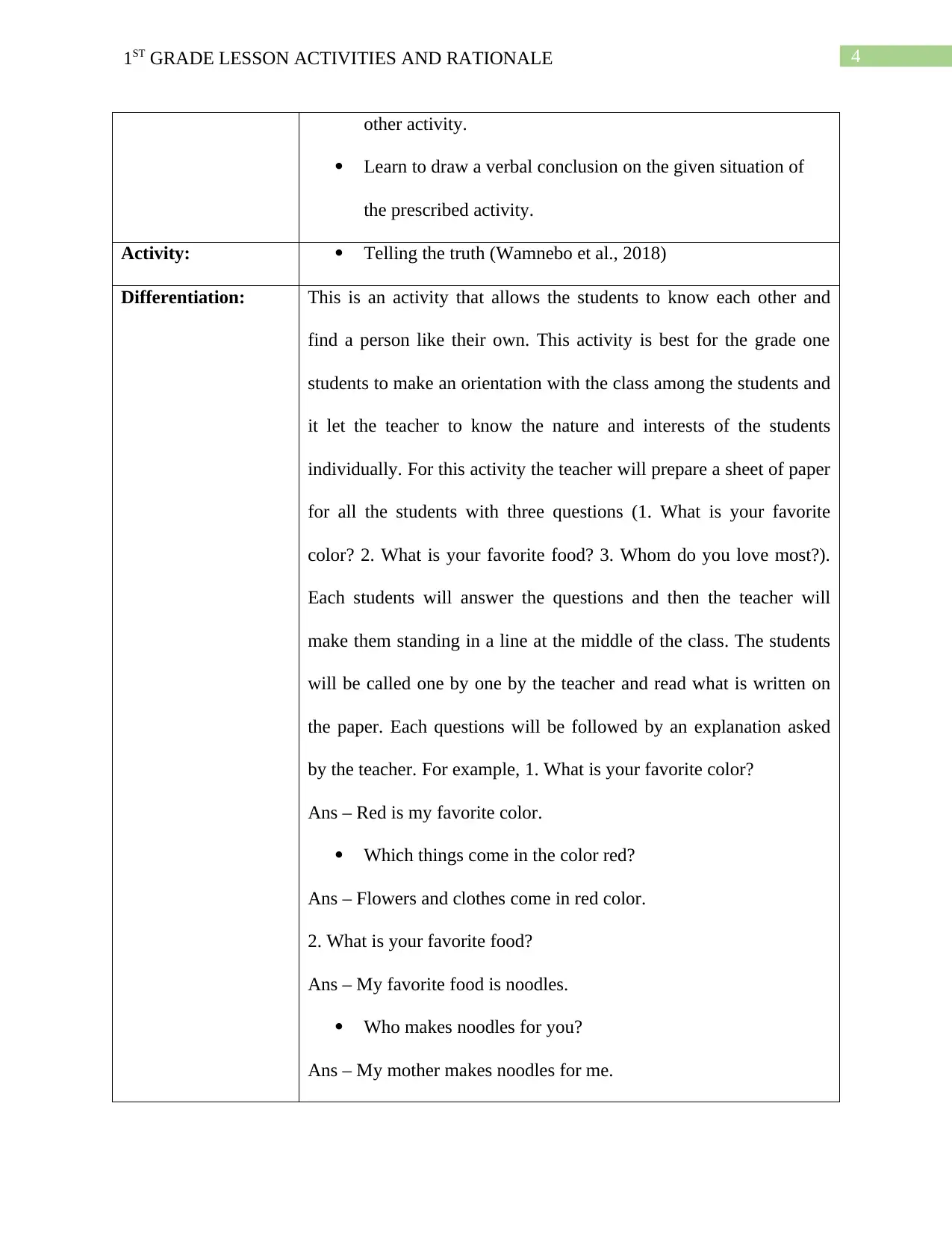
41ST GRADE LESSON ACTIVITIES AND RATIONALE
other activity.
Learn to draw a verbal conclusion on the given situation of
the prescribed activity.
Activity: Telling the truth (Wamnebo et al., 2018)
Differentiation: This is an activity that allows the students to know each other and
find a person like their own. This activity is best for the grade one
students to make an orientation with the class among the students and
it let the teacher to know the nature and interests of the students
individually. For this activity the teacher will prepare a sheet of paper
for all the students with three questions (1. What is your favorite
color? 2. What is your favorite food? 3. Whom do you love most?).
Each students will answer the questions and then the teacher will
make them standing in a line at the middle of the class. The students
will be called one by one by the teacher and read what is written on
the paper. Each questions will be followed by an explanation asked
by the teacher. For example, 1. What is your favorite color?
Ans – Red is my favorite color.
Which things come in the color red?
Ans – Flowers and clothes come in red color.
2. What is your favorite food?
Ans – My favorite food is noodles.
Who makes noodles for you?
Ans – My mother makes noodles for me.
other activity.
Learn to draw a verbal conclusion on the given situation of
the prescribed activity.
Activity: Telling the truth (Wamnebo et al., 2018)
Differentiation: This is an activity that allows the students to know each other and
find a person like their own. This activity is best for the grade one
students to make an orientation with the class among the students and
it let the teacher to know the nature and interests of the students
individually. For this activity the teacher will prepare a sheet of paper
for all the students with three questions (1. What is your favorite
color? 2. What is your favorite food? 3. Whom do you love most?).
Each students will answer the questions and then the teacher will
make them standing in a line at the middle of the class. The students
will be called one by one by the teacher and read what is written on
the paper. Each questions will be followed by an explanation asked
by the teacher. For example, 1. What is your favorite color?
Ans – Red is my favorite color.
Which things come in the color red?
Ans – Flowers and clothes come in red color.
2. What is your favorite food?
Ans – My favorite food is noodles.
Who makes noodles for you?
Ans – My mother makes noodles for me.
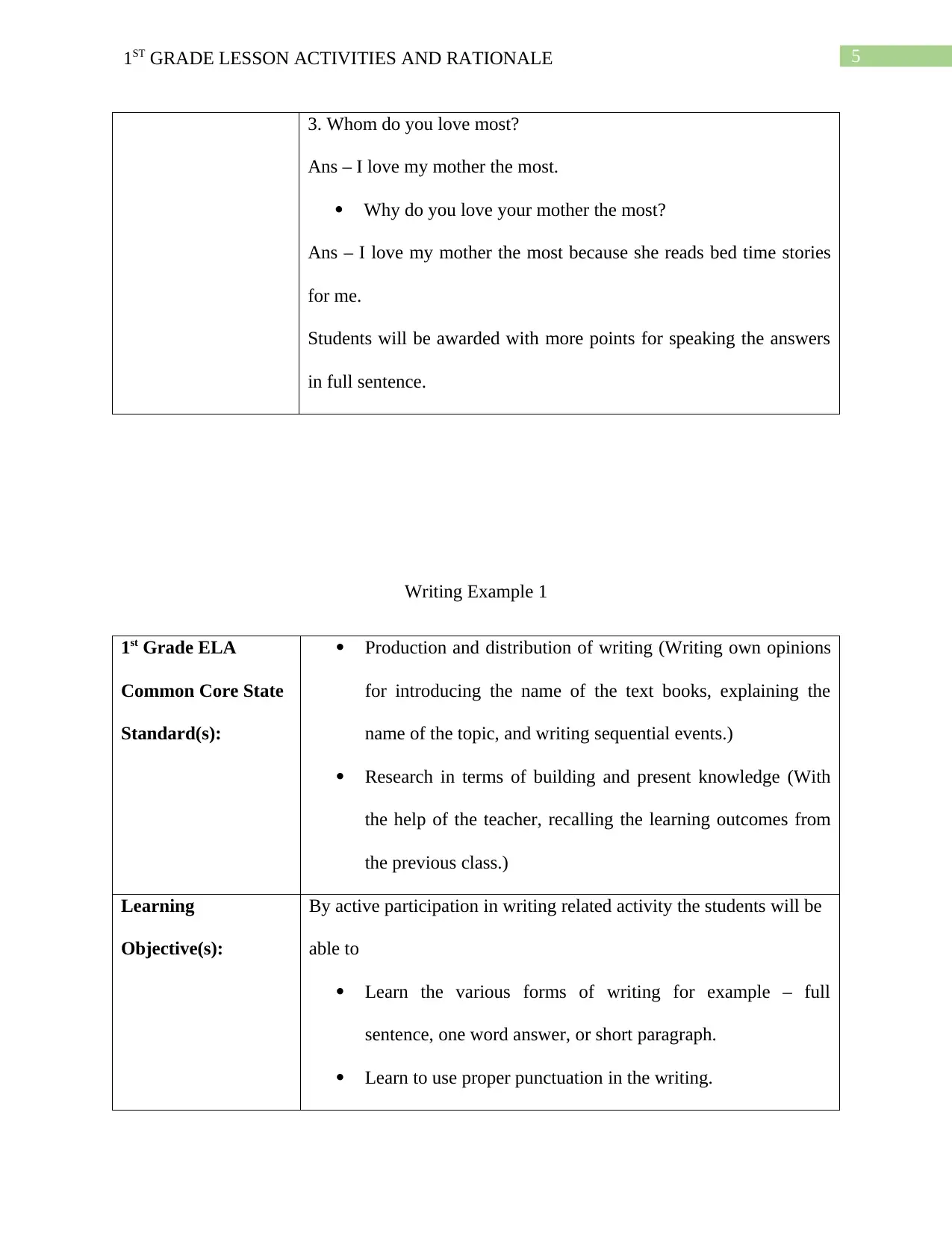
51ST GRADE LESSON ACTIVITIES AND RATIONALE
3. Whom do you love most?
Ans – I love my mother the most.
Why do you love your mother the most?
Ans – I love my mother the most because she reads bed time stories
for me.
Students will be awarded with more points for speaking the answers
in full sentence.
Writing Example 1
1st Grade ELA
Common Core State
Standard(s):
Production and distribution of writing (Writing own opinions
for introducing the name of the text books, explaining the
name of the topic, and writing sequential events.)
Research in terms of building and present knowledge (With
the help of the teacher, recalling the learning outcomes from
the previous class.)
Learning
Objective(s):
By active participation in writing related activity the students will be
able to
Learn the various forms of writing for example – full
sentence, one word answer, or short paragraph.
Learn to use proper punctuation in the writing.
3. Whom do you love most?
Ans – I love my mother the most.
Why do you love your mother the most?
Ans – I love my mother the most because she reads bed time stories
for me.
Students will be awarded with more points for speaking the answers
in full sentence.
Writing Example 1
1st Grade ELA
Common Core State
Standard(s):
Production and distribution of writing (Writing own opinions
for introducing the name of the text books, explaining the
name of the topic, and writing sequential events.)
Research in terms of building and present knowledge (With
the help of the teacher, recalling the learning outcomes from
the previous class.)
Learning
Objective(s):
By active participation in writing related activity the students will be
able to
Learn the various forms of writing for example – full
sentence, one word answer, or short paragraph.
Learn to use proper punctuation in the writing.
⊘ This is a preview!⊘
Do you want full access?
Subscribe today to unlock all pages.

Trusted by 1+ million students worldwide
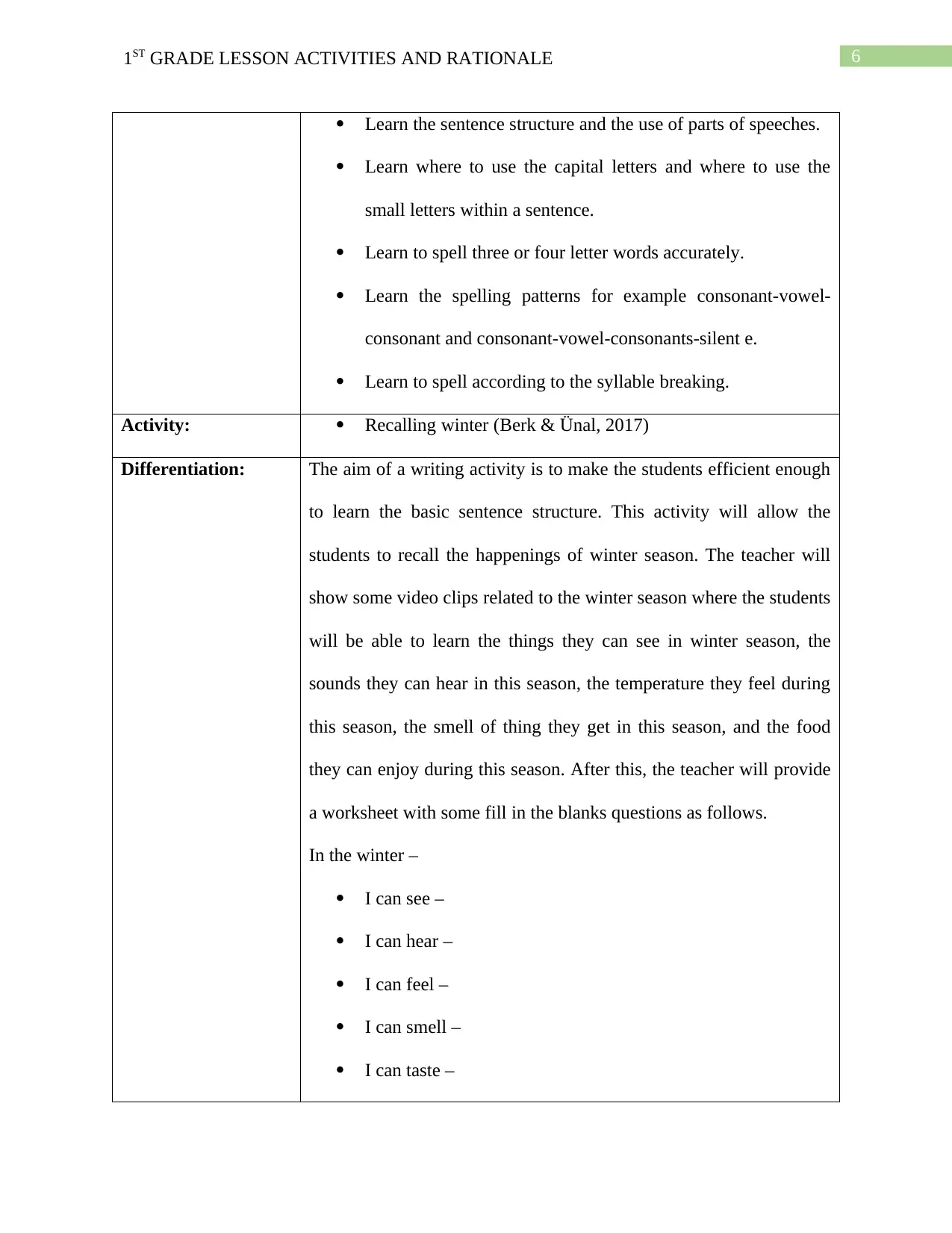
61ST GRADE LESSON ACTIVITIES AND RATIONALE
Learn the sentence structure and the use of parts of speeches.
Learn where to use the capital letters and where to use the
small letters within a sentence.
Learn to spell three or four letter words accurately.
Learn the spelling patterns for example consonant-vowel-
consonant and consonant-vowel-consonants-silent e.
Learn to spell according to the syllable breaking.
Activity: Recalling winter (Berk & Ünal, 2017)
Differentiation: The aim of a writing activity is to make the students efficient enough
to learn the basic sentence structure. This activity will allow the
students to recall the happenings of winter season. The teacher will
show some video clips related to the winter season where the students
will be able to learn the things they can see in winter season, the
sounds they can hear in this season, the temperature they feel during
this season, the smell of thing they get in this season, and the food
they can enjoy during this season. After this, the teacher will provide
a worksheet with some fill in the blanks questions as follows.
In the winter –
I can see –
I can hear –
I can feel –
I can smell –
I can taste –
Learn the sentence structure and the use of parts of speeches.
Learn where to use the capital letters and where to use the
small letters within a sentence.
Learn to spell three or four letter words accurately.
Learn the spelling patterns for example consonant-vowel-
consonant and consonant-vowel-consonants-silent e.
Learn to spell according to the syllable breaking.
Activity: Recalling winter (Berk & Ünal, 2017)
Differentiation: The aim of a writing activity is to make the students efficient enough
to learn the basic sentence structure. This activity will allow the
students to recall the happenings of winter season. The teacher will
show some video clips related to the winter season where the students
will be able to learn the things they can see in winter season, the
sounds they can hear in this season, the temperature they feel during
this season, the smell of thing they get in this season, and the food
they can enjoy during this season. After this, the teacher will provide
a worksheet with some fill in the blanks questions as follows.
In the winter –
I can see –
I can hear –
I can feel –
I can smell –
I can taste –
Paraphrase This Document
Need a fresh take? Get an instant paraphrase of this document with our AI Paraphraser
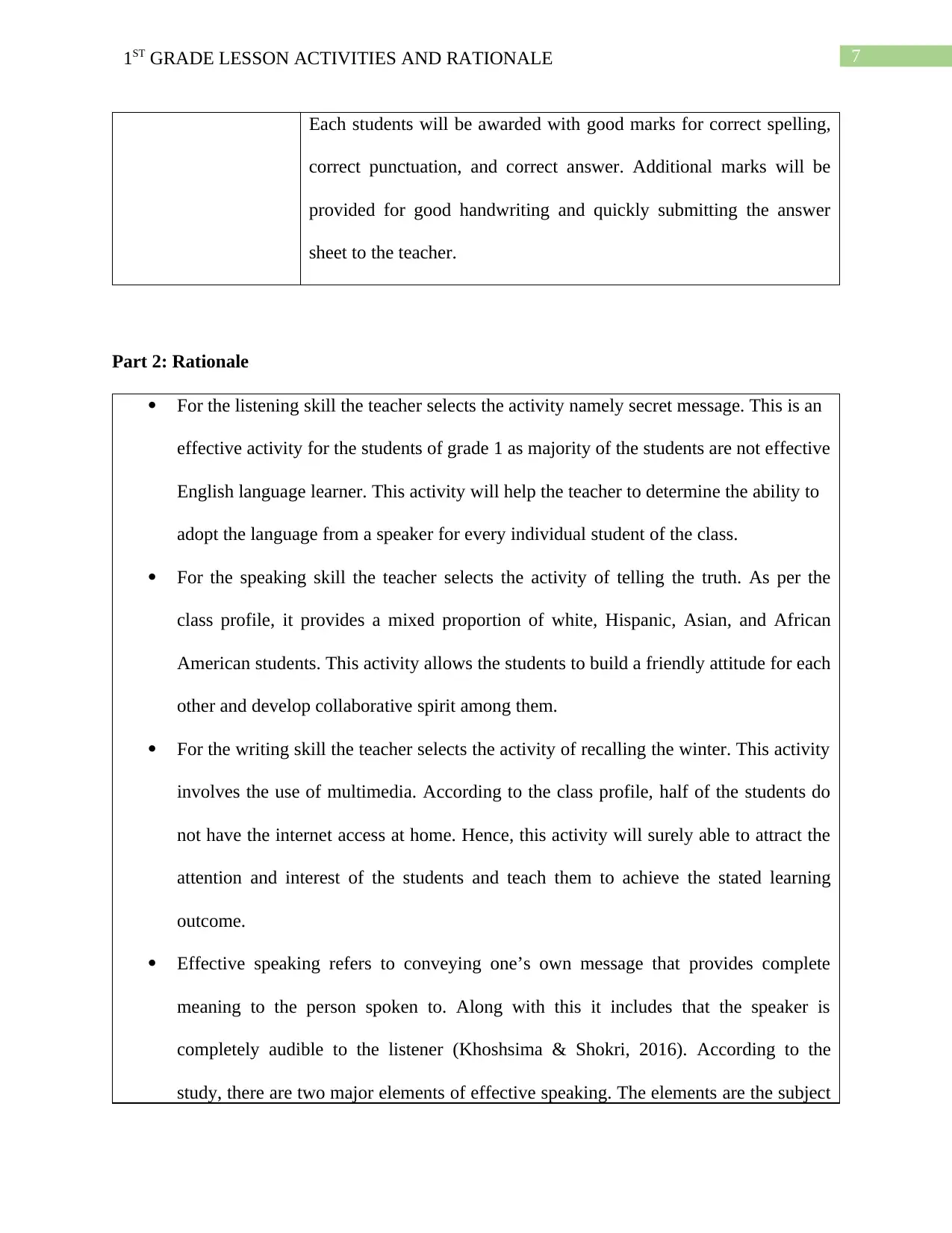
71ST GRADE LESSON ACTIVITIES AND RATIONALE
Each students will be awarded with good marks for correct spelling,
correct punctuation, and correct answer. Additional marks will be
provided for good handwriting and quickly submitting the answer
sheet to the teacher.
Part 2: Rationale
For the listening skill the teacher selects the activity namely secret message. This is an
effective activity for the students of grade 1 as majority of the students are not effective
English language learner. This activity will help the teacher to determine the ability to
adopt the language from a speaker for every individual student of the class.
For the speaking skill the teacher selects the activity of telling the truth. As per the
class profile, it provides a mixed proportion of white, Hispanic, Asian, and African
American students. This activity allows the students to build a friendly attitude for each
other and develop collaborative spirit among them.
For the writing skill the teacher selects the activity of recalling the winter. This activity
involves the use of multimedia. According to the class profile, half of the students do
not have the internet access at home. Hence, this activity will surely able to attract the
attention and interest of the students and teach them to achieve the stated learning
outcome.
Effective speaking refers to conveying one’s own message that provides complete
meaning to the person spoken to. Along with this it includes that the speaker is
completely audible to the listener (Khoshsima & Shokri, 2016). According to the
study, there are two major elements of effective speaking. The elements are the subject
Each students will be awarded with good marks for correct spelling,
correct punctuation, and correct answer. Additional marks will be
provided for good handwriting and quickly submitting the answer
sheet to the teacher.
Part 2: Rationale
For the listening skill the teacher selects the activity namely secret message. This is an
effective activity for the students of grade 1 as majority of the students are not effective
English language learner. This activity will help the teacher to determine the ability to
adopt the language from a speaker for every individual student of the class.
For the speaking skill the teacher selects the activity of telling the truth. As per the
class profile, it provides a mixed proportion of white, Hispanic, Asian, and African
American students. This activity allows the students to build a friendly attitude for each
other and develop collaborative spirit among them.
For the writing skill the teacher selects the activity of recalling the winter. This activity
involves the use of multimedia. According to the class profile, half of the students do
not have the internet access at home. Hence, this activity will surely able to attract the
attention and interest of the students and teach them to achieve the stated learning
outcome.
Effective speaking refers to conveying one’s own message that provides complete
meaning to the person spoken to. Along with this it includes that the speaker is
completely audible to the listener (Khoshsima & Shokri, 2016). According to the
study, there are two major elements of effective speaking. The elements are the subject
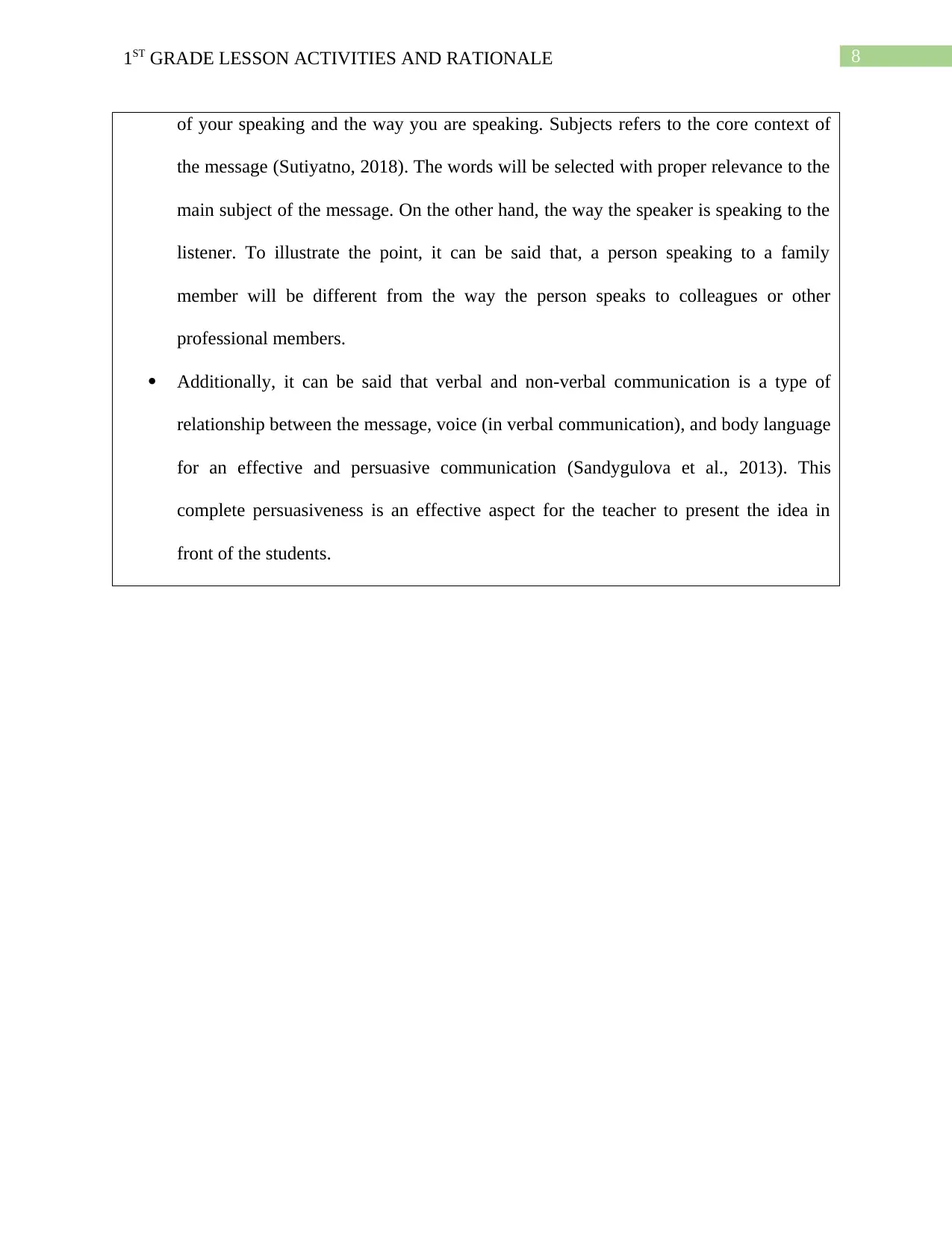
81ST GRADE LESSON ACTIVITIES AND RATIONALE
of your speaking and the way you are speaking. Subjects refers to the core context of
the message (Sutiyatno, 2018). The words will be selected with proper relevance to the
main subject of the message. On the other hand, the way the speaker is speaking to the
listener. To illustrate the point, it can be said that, a person speaking to a family
member will be different from the way the person speaks to colleagues or other
professional members.
Additionally, it can be said that verbal and non-verbal communication is a type of
relationship between the message, voice (in verbal communication), and body language
for an effective and persuasive communication (Sandygulova et al., 2013). This
complete persuasiveness is an effective aspect for the teacher to present the idea in
front of the students.
of your speaking and the way you are speaking. Subjects refers to the core context of
the message (Sutiyatno, 2018). The words will be selected with proper relevance to the
main subject of the message. On the other hand, the way the speaker is speaking to the
listener. To illustrate the point, it can be said that, a person speaking to a family
member will be different from the way the person speaks to colleagues or other
professional members.
Additionally, it can be said that verbal and non-verbal communication is a type of
relationship between the message, voice (in verbal communication), and body language
for an effective and persuasive communication (Sandygulova et al., 2013). This
complete persuasiveness is an effective aspect for the teacher to present the idea in
front of the students.
⊘ This is a preview!⊘
Do you want full access?
Subscribe today to unlock all pages.

Trusted by 1+ million students worldwide
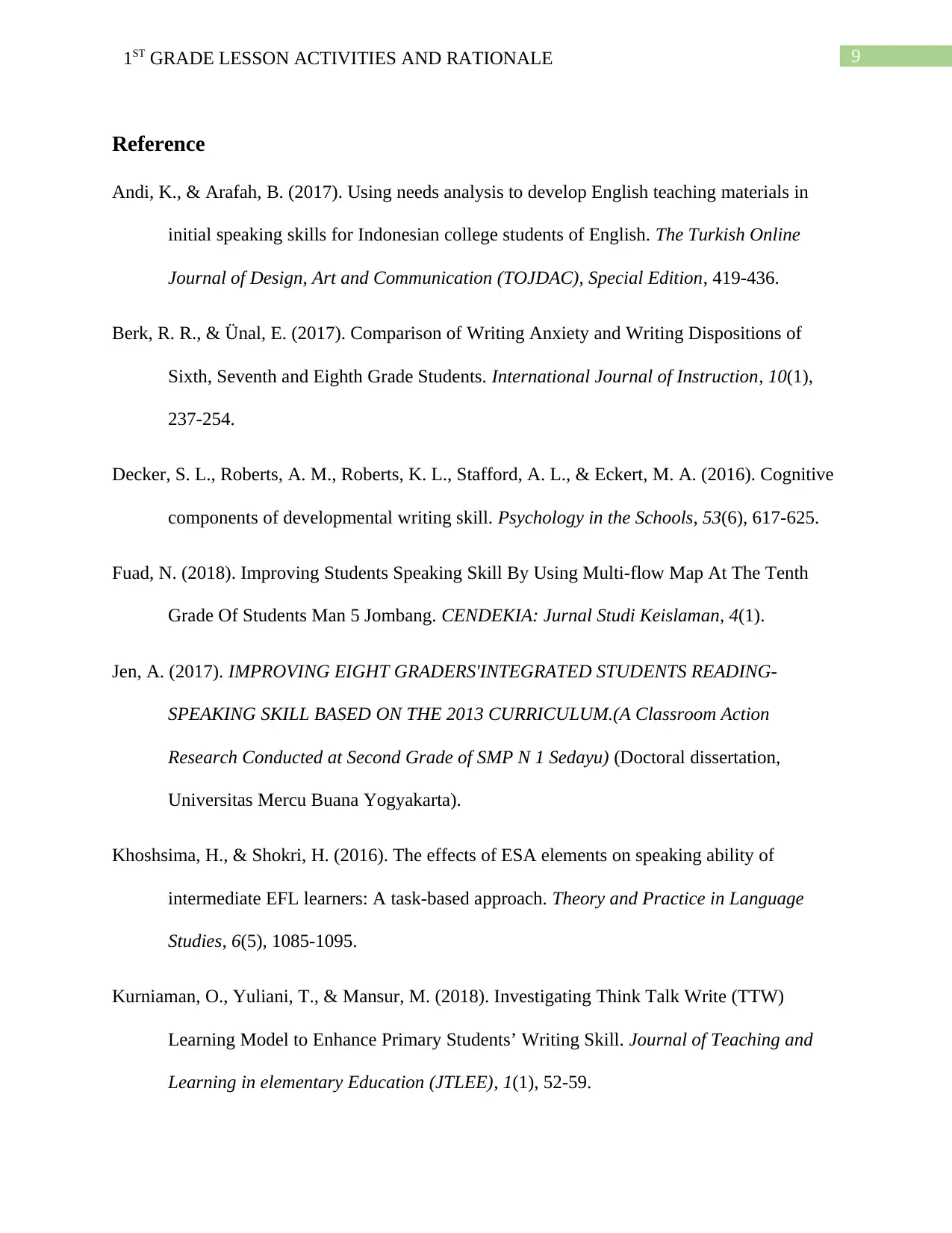
91ST GRADE LESSON ACTIVITIES AND RATIONALE
Reference
Andi, K., & Arafah, B. (2017). Using needs analysis to develop English teaching materials in
initial speaking skills for Indonesian college students of English. The Turkish Online
Journal of Design, Art and Communication (TOJDAC), Special Edition, 419-436.
Berk, R. R., & Ünal, E. (2017). Comparison of Writing Anxiety and Writing Dispositions of
Sixth, Seventh and Eighth Grade Students. International Journal of Instruction, 10(1),
237-254.
Decker, S. L., Roberts, A. M., Roberts, K. L., Stafford, A. L., & Eckert, M. A. (2016). Cognitive
components of developmental writing skill. Psychology in the Schools, 53(6), 617-625.
Fuad, N. (2018). Improving Students Speaking Skill By Using Multi-flow Map At The Tenth
Grade Of Students Man 5 Jombang. CENDEKIA: Jurnal Studi Keislaman, 4(1).
Jen, A. (2017). IMPROVING EIGHT GRADERS'INTEGRATED STUDENTS READING-
SPEAKING SKILL BASED ON THE 2013 CURRICULUM.(A Classroom Action
Research Conducted at Second Grade of SMP N 1 Sedayu) (Doctoral dissertation,
Universitas Mercu Buana Yogyakarta).
Khoshsima, H., & Shokri, H. (2016). The effects of ESA elements on speaking ability of
intermediate EFL learners: A task-based approach. Theory and Practice in Language
Studies, 6(5), 1085-1095.
Kurniaman, O., Yuliani, T., & Mansur, M. (2018). Investigating Think Talk Write (TTW)
Learning Model to Enhance Primary Students’ Writing Skill. Journal of Teaching and
Learning in elementary Education (JTLEE), 1(1), 52-59.
Reference
Andi, K., & Arafah, B. (2017). Using needs analysis to develop English teaching materials in
initial speaking skills for Indonesian college students of English. The Turkish Online
Journal of Design, Art and Communication (TOJDAC), Special Edition, 419-436.
Berk, R. R., & Ünal, E. (2017). Comparison of Writing Anxiety and Writing Dispositions of
Sixth, Seventh and Eighth Grade Students. International Journal of Instruction, 10(1),
237-254.
Decker, S. L., Roberts, A. M., Roberts, K. L., Stafford, A. L., & Eckert, M. A. (2016). Cognitive
components of developmental writing skill. Psychology in the Schools, 53(6), 617-625.
Fuad, N. (2018). Improving Students Speaking Skill By Using Multi-flow Map At The Tenth
Grade Of Students Man 5 Jombang. CENDEKIA: Jurnal Studi Keislaman, 4(1).
Jen, A. (2017). IMPROVING EIGHT GRADERS'INTEGRATED STUDENTS READING-
SPEAKING SKILL BASED ON THE 2013 CURRICULUM.(A Classroom Action
Research Conducted at Second Grade of SMP N 1 Sedayu) (Doctoral dissertation,
Universitas Mercu Buana Yogyakarta).
Khoshsima, H., & Shokri, H. (2016). The effects of ESA elements on speaking ability of
intermediate EFL learners: A task-based approach. Theory and Practice in Language
Studies, 6(5), 1085-1095.
Kurniaman, O., Yuliani, T., & Mansur, M. (2018). Investigating Think Talk Write (TTW)
Learning Model to Enhance Primary Students’ Writing Skill. Journal of Teaching and
Learning in elementary Education (JTLEE), 1(1), 52-59.
Paraphrase This Document
Need a fresh take? Get an instant paraphrase of this document with our AI Paraphraser
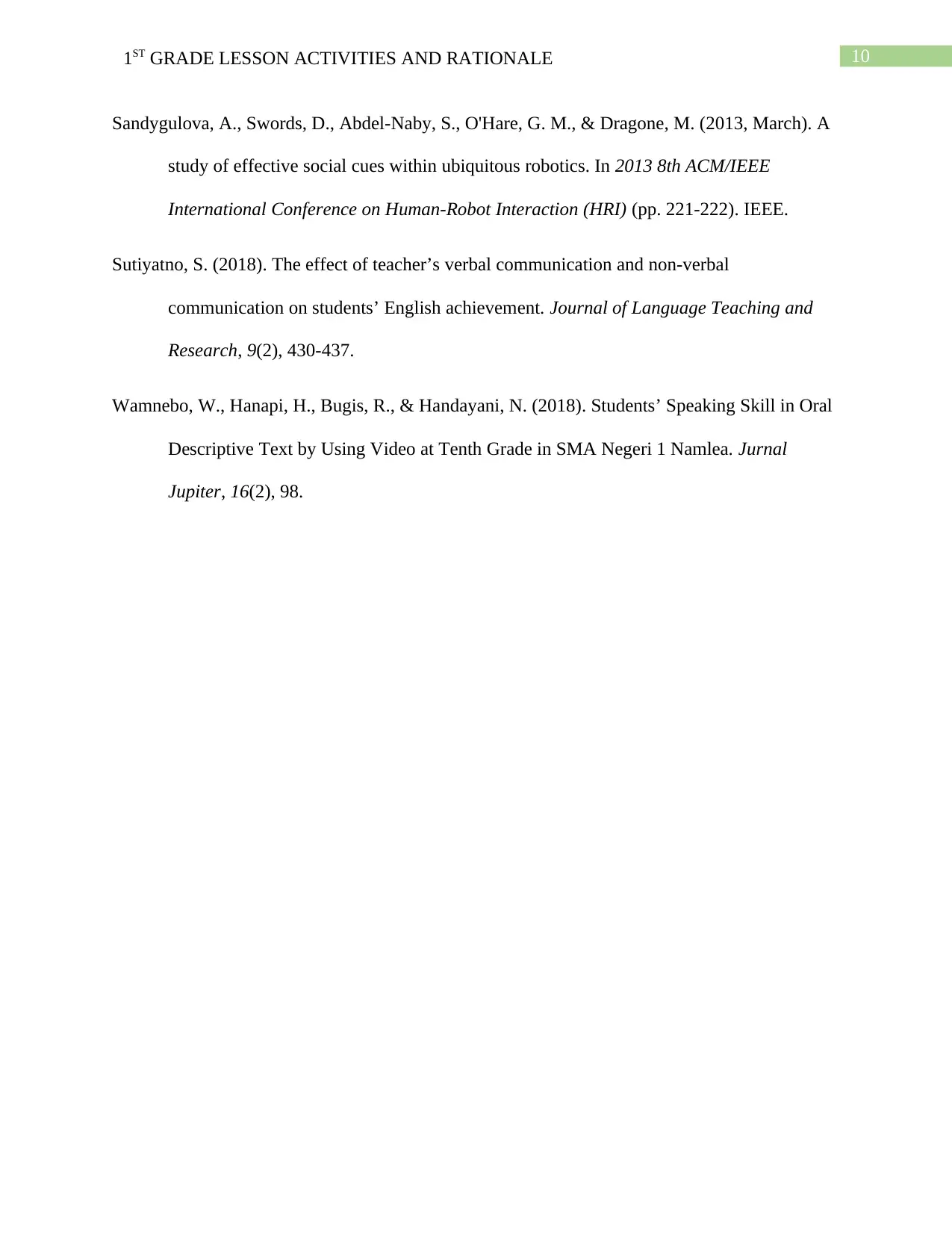
101ST GRADE LESSON ACTIVITIES AND RATIONALE
Sandygulova, A., Swords, D., Abdel-Naby, S., O'Hare, G. M., & Dragone, M. (2013, March). A
study of effective social cues within ubiquitous robotics. In 2013 8th ACM/IEEE
International Conference on Human-Robot Interaction (HRI) (pp. 221-222). IEEE.
Sutiyatno, S. (2018). The effect of teacher’s verbal communication and non-verbal
communication on students’ English achievement. Journal of Language Teaching and
Research, 9(2), 430-437.
Wamnebo, W., Hanapi, H., Bugis, R., & Handayani, N. (2018). Students’ Speaking Skill in Oral
Descriptive Text by Using Video at Tenth Grade in SMA Negeri 1 Namlea. Jurnal
Jupiter, 16(2), 98.
Sandygulova, A., Swords, D., Abdel-Naby, S., O'Hare, G. M., & Dragone, M. (2013, March). A
study of effective social cues within ubiquitous robotics. In 2013 8th ACM/IEEE
International Conference on Human-Robot Interaction (HRI) (pp. 221-222). IEEE.
Sutiyatno, S. (2018). The effect of teacher’s verbal communication and non-verbal
communication on students’ English achievement. Journal of Language Teaching and
Research, 9(2), 430-437.
Wamnebo, W., Hanapi, H., Bugis, R., & Handayani, N. (2018). Students’ Speaking Skill in Oral
Descriptive Text by Using Video at Tenth Grade in SMA Negeri 1 Namlea. Jurnal
Jupiter, 16(2), 98.
1 out of 11
Related Documents
Your All-in-One AI-Powered Toolkit for Academic Success.
+13062052269
info@desklib.com
Available 24*7 on WhatsApp / Email
![[object Object]](/_next/static/media/star-bottom.7253800d.svg)
Unlock your academic potential
Copyright © 2020–2025 A2Z Services. All Rights Reserved. Developed and managed by ZUCOL.





